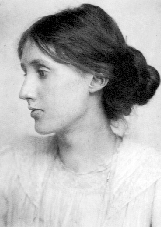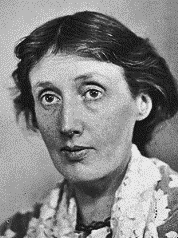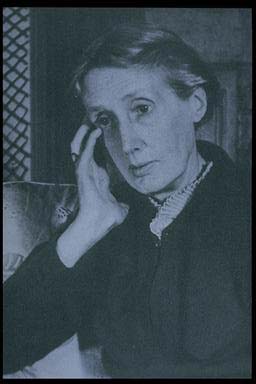WOOLF, (ADELINE) VIRGINIA (STEPHEN) (January
25, 1882-March 28, 1941),
English novelist and critic, was born in London.
Virginia Stephen was a member of
an upper middle-class family, with interesting
antecedents and connections. Her
father was Sir Leslie Stephen, critic and
first editor of the Dictionary of National
Biography; her mother, Julia, widow of Herbert
Duckworth and niece of the pioneer
photographer Julia Margaret Cameron, was his
second wife. Virginia, known
affectionately to her siblings as "the Goat,"
was the third of four children, preceded
by Vanessa, later a painter and wife of the
art critic Clive Bell, and Thoby, who died
of typhoid fever in 1906, soon after taking
his degree at Cambridge. Thoby's
university friends formed the nucleus of the
Bloomsbury group, which included the
philosopher G. E. Moore, E. M. Forster, and
many other notables. The youngest child
was Adrian, who eventually became a physician.
At one time or another the Stephen
household also numbered Sir Leslie's daughter
by his first wife, and the three
Duckworth children, George, Stella, and Gerald
(later the founder of Duckworth and
Company Publishers)--who played key roles
in Virginia Stephen's early life.
The two Stephen daughters were educated for
the most part by their parents, at
home, and in her adolescence Virginia was
given the run of her father's library. Her
hours of reading there were her real education,
to some extent a substitute for the
university courses she was denied because
of her sex. Virginia Stephen's writing
career may be said to have begun when she
was nine years old and started a
weekly paper, The Hyde Park Gate News, chronicling
family doings in their
Kensington home and at Talland House in St.
Ives, Cornwall, where they spent their
summers from 1882 to 1894. Guests there included,
besides family members in
great numbers, her father's friends George
Meredith, Ralph Waldo Emerson, James
Russell Lowell, and Henry James. In one of
her news pieces she reports about a trip
to the nearby lighthouse, since "there was
a prefect tide and wind for going there."
As Quentin Bell, in his biography of his aunt,
states: "St. Ives provided a treasury of
reminiscent gold from which she drew again
and again.. . .Cornwall was the Eden of
her youth, an unforgettable paradise." It
was the setting for Jacob's Room, The
Waves, and--above all--To the Lighthouse,
though in the latter the summer home of
the Ramsays becomes the Isle of Skye. In Mrs.
Ramsay, the woman who holds them
all, family and friends, together, the novelist
portrayed her mother. In 1895, when
Virginia was thirteen, Julia Stephen died.
It was at this time that she first suffered
symptoms of the recurrent mental illness which
was to plague her life.
Woolf suffered from "mixed states " of depression
and elation. Sometimes in these
troubled years Virginia was disturbed further
by the sexual advances of her
half-brother George Duckworth. (He remained
a tolerated but persistently
troublesome presence in her life until she
was in her twenties). The extent of his
intrusion into her life has, however, been
exaggerated by some critics. In the novel
Mrs. Dalloway, Woolf gives a graphic account
of the experience of insanity, through
the ramblings of Septimus Warren Smith, whose
descent into madness weaves
through the events of a summer day in London.
After Stella's death, Virginia was well enough
later that year to start the serious study
of Greek and Latin, first at King's College,
London, and later at home. The death of
her father in 1904, however, set off another
breakdown and a suicide attempt. "All
that summer she was mad," is Quentin Bell's
laconic comment.
But that year was, in other respects a watershed
one; Vanessa, Virginia, and Adrian
Stephen moved into their own home on Gordon
Square, in Bloomsbury--the house to
which their brother Thoby, in 1905, brought
his Cambridge friends to visit. These first
"Bloomsbury" gatherings included Clive Bell,
Lytton Strachey, and the mysterious
"wild man" Leonard Woolf. (The art critic
Roger Fry and the novelist E. M. Forster,
who became Virginia's particular friends,
were drawn into the circle about 1910-11).
Also in 1904, thanks to an introduction from
her friend Violet Dickinson, Virginia
Stephen began to do regular articles and reviews
for the Guardian. Her first review,
of William Dean Howells's The Son of Royal
Langbrigh, appeared on December 14;
an article on the Bronte parsonage appeared
the following week. From about the
age of fifteen she had been training herself
to write professionally, keeping journal
notebooks in which she described her round
of activities and acquaintances. Seven
of these journals (kept up until 1909) have
been published under the title A
Passionate Apprentice. In one of the later
entries she declares that she intends in
her writing to "achieve a symmetry by means
of infinite discords, showing all the
traces of the mind's sick passage through
the world.. . ." In 1905 she began to write
reviews for the Times Literary Supplement,
and did so for the rest of her life. Toward
the end of that year, also, she was invited
to teach at Morley College, an institute for
working class men and women; until 1907 she
lectured informally on English
literature and history.
Then once again, in 1906, disaster struck:
the death of Thoby (after they had all been
on a trip to Greece) and, within days, the
announcement of Vanessa's engagement
to Clive Bell. Coping successfully with this,
she and Adrian took a house on Fitzroy
Square.
Leonard Woolf returned from his civil service
post in Ceylon, fell deeply in love with
Virginia and proposed to her in January 1912;
by May--despite doubts about her
readiness for marriage, and to "a penniless
Jew" (as she described him to Violet
Dickinson)--she accepted him. "It was the
wisest decision of her life," her nephew
concluded.
This was the start of a singular relationship
that owed much to Leonard Woolf's
understanding and devotion. In the spring
of 1913 The Voyage Out was finished and
accepted by Gerald Duckworth's firm. It is
a novel of self-discovery, a voyage within.
For all its ultimate sadness--sudden death
ending Rachell Vinrace's growth of
awareness--it has touches of sly humor that
became characteristic of Woolf's
style--such as a description of Rachel's fellow
passengers on the ship bound for
South America, as they might look from afar:
"lumps on the rigging. Mr. Pepper with
all his learning had been mistaken for a cormorant,
and then. . .transformed into a
cow." Among these passengers is Clarissa Dalloway,
the complacent, seemingly
assured society wife who becomes the eponymous
heroine of one of Woolf's
greatest novels. Publication of the book made
her excited and ill. After her slow
recovery at Asheham, the country home she
had bought in Sussex, the Woolfs came
back to London and settled at Hogarth House
in Richmond (safely distant from
"rackety" parties in Bloomsbury), where they
lived from 1915 to 1924. Intelligent
reviews in the English press (especially by
Forster) helped rally her, and by 1918 she
was at work on Night and Day, and beginning
to keep the diary in which she wrote
fairly regularly until a few days before her
death. These spontaneous jottings,
generally penned after teatime, sketch doings
and people, and comment on the
progress of her writing.
In 1917 Leonard Woolf set up a small hand press
at Hogarth House. They both
learned how to set type, and in time presided
over the growth of a small but
distinguished publishing firm, the Hogarth
Press, of which Woolf remained a director
until his death.
Night and Day is dedicated to Vanessa Bell;
and the heroine, a young woman born
into a family of writers but whose secret
passion is mathematics, is in part based on
her. It was published about the time the Woolfs
took another country home, Monks
House, near Rodmell, Sussex--the farmhouse
where Vanessa Bell, her children, and
her lover the painter Duncan Grant, had been
living since 1916. Katherine Mansfield
(whose own collection of short stories, Prelude,
was the second work published by
the Hogarth Press) found Night and Day "cultivated,
distinguished and brilliant" but
too deliberate (Athenaeum). Forster, whose
opinion Woolf always especially valued,
was also unsympathetic. With Jacob's Room,
the first full-length book published by
the Hogarth Press, Woolf's later style begins.
Plot is nonexistent, metaphor and
symbol are substitutes for action, and character
is revealed by the flow of interior
monologue. Interior reality transcends external
events, though Woolf's aim was
always to unite them. The impressionistic
portrait of Jacob Flanders (a young man
with obvious references to Thoby Stephen),
from boyhood to death in the war, is built
of random reflections: of his room, of character-revealing
incidents, of comments by
his friends. Many reviewers were left asking
what the book was about. John
Middleton Murry (Woolf noted in her diary)
was sure its writing was a dead end for
her. The book was on the whole a popular success.
When Arnold Bennett objected
that she could not create living, memorable
characters, she replied in a famously
angry lecture, "Mr. Bennett and Mrs. Brown,"
read at Cambridge in 1924 and
published in the essay collection The Captain's
Death Bed. Here she speculates on
how the Edwardian writers Bennett, H. G. Wells,
and John Galsworthy might
describe a hypothetical "Mrs. Brown." None
of them, she thought, would get beyond
the externals and capture Mrs. Brown's sense
of herself. This was to be the mission
of Forster, Joyce, D. H. Lawrence, and Woolf
herself.
In June 1924 she began Mrs. Dalloway; it was
finished later that year. A "radial" not
"linear" narrative, as the author described
it, it spins off in many directions to explore
the sources of Clarissa Dalloway's being.
The exploration is confined to the events of
one day in her life, as she prepares for an
evening party, the hours marked by the
strokes of Big Ben: the "leaden circles" that
"dissolved in the air."
By March 1926 Woolf was at work on To the Lighthouse.
She found it came more
easily than any of her other novels. She told
her friend Roger Fry: "I meant nothing by
it. One has to have a central line drawn down
the middle of the book to hold the
design together. I saw that all sorts of feelings
would accrue to this, but I refused to
think them out.. . .I can't manage Symbolism
except in this vague, generalised way."
The novel, "made from the passions and tragedies
of her youth" (Quentin Bell), is a
mix of pathos and absurdity, just bordering
on satire of some of the Ramsays's
famous guests.
Clive Bell gave a dinner party in 1922, at
which he introduced Virginia Woolf to Vita
Sackville-West. The friendship grew, and somewhere
between 1925 and 1929
developed into a love affair. Virginia's letters
to Vita are included in volume three of
the complete edition of Woolf's letters. Another
form of "love letter" (as Nigel
Nicolson, Vita's son called it) is Orlando,
the jeu d'esprit, part masque, part pageant,
written for and dedicated to her friend. It
is, as Nicolson describes it, an
"experimental novel that follows its central
character through several centuries and
identities"; Vita, as Orlando, plays her part
in Sackville family history, an Elizabethan
courtier at the start, a modern-day young
man at its close. On another level, the book
is certainly a spoof of conventional biographies.
In any case, it was a commercial
success, accepted as a "highbrow" novel that
was actually funny and easy to read.
The fiction that followed was very different.
For some time Woolf struggled with the
writing of a book to be called The Moths,
finally completed as The Waves. It is her
most difficult book (and in the opinion of
Leonard Woolf her greatest), composed of
the soliloquies of six friends that reveal
their lives over the years. The Times Literary
Supplement felt it was an admirable technical
experiment, but left a sense of void;
other critics have been more explicitly negative.
Just before this, Woolf had finished
the work that is now closely associated with
her in the minds of some feminist critics.
A Room of One's Own began as lectures read
at Newnham and Girton colleges,
Cambridge, in October 1928. Prefacing it with
a story of how, as a woman, she had
been turned away from one of the university
libraries, she goes on to describe the
barriers put in the way of women writers,
concluding that to achieve intellectual
freedom a woman must have a source of income
and a room of her own. Three
Guineas, published on the eve of World War
II, is an outspoken, more general
protest on women's place in contemporary English
political and social life.
The Years, the last novel published during
her lifetime, is the story of the Pargiter
family, taking them from 1880 to the present.
Although plot and character are
eschewed (time itself is the chief character),
its straightforward narration, mainly in
the form of dialogue, appeared to be a regression
from the style she had been
forging. Her husband, as always her final
critic, was disappointed; again, however, it
proved popular with readers. As originally
drafted, The Pargiters alternated narrative
with didactic essays on the predicament of
women. These are now available in an
edition published by the scholar Mitchell
A. Leaska, titled The Pargiters: The
Novel-Essay Portion of "The Years". Two quite
different works followed. Flush, a
"biography" of Elizabeth Barrett Browning's
spaniel, is in fact a description of
Wimpole Street and Italy--and of the poet--from
a pet's point of view. Flush,
according to David Garnett, was "the first
animal to become an Eminent Victorian"
(New Statesman and Nation). Roger Fry, a life
of the critic who introduced Cezanne
and modern art to English viewers, was undertaken
at his family's request after his
death in 1934. Despite her difficulties with
writing about art and about his love
affairs, the work turned out to be firm, direct,
understanding, and--in view of their long
and intimate friendship--surprisingly objective
(Herbert Read, Spectator). Vanessa
Bell is reported to have said of the book:
"Now you have given him back to me."
Family and time are again, as always, the center
of Virginia Woolf's last novel,
Between the Acts, completed a month before
her death, and to have been titled
Pointz Hall. Here, in the course of a summer
day, an English family and their guests
gather at the great house to attend the villagers'
historical pageant. Scene and
"action" are made manifest by the interior
monologues carried on by members of the
family.
On March 28, in a fit of depression, Woolf
drowned herself in the River Ouse, leaving
a note for her husband in which she assured
him that "I owe all the happiness of my
life to you," and "I don't think two people
could have been happier than we have
been." Through his devoted efforts, much of
her previously unpublished work was
issued thereafter, as well as collections
of her essays and stories, and her
correspondence with Lytton Strachey. Since
his death in 1969, an enormous Virginia
Woolf bibliography has accumulated; of these
at least A Writer's Diary and Quentin
Bell's detailed biography remain essential.
There are now complete editions of her
letters and the diaries. The Bloomsbury group
and her relations with it continue to
fascinate.
By the 1930s some critics had begun to dismiss
Woolf as irrelevant, too distanced
from contemporary concerns, overlooking her
long commitment to liberal-leftist
social causes: women's suffrage, the Women's
Co-Operative Guild, pacifism and
antifascism. Feminist critics have suggested
that anger at male dominance is at the
core of her writing. Both she and her husband
Leonard refused a Companion of
Honor in 1935. She turned down many academic
awards, but did accept the
Femina-Vie Heureuse Prize in 1938. In his
memorial address, given as the Rede
Lecture at Cambridge in 1941, E. M. Forster
spoke of Woolf's singleness of
aesthetic purpose and the joy in her work.
The major collection of Virginia Woolf's manuscripts,
drafts, and correspondence is
housed in the Berg Collection at the New York
Public Library; there are collections of
her papers at Monks House and the British
Museum.
Adapted from data developed by the H.W.
Wilson Company, Inc.
Copyright © 1996-99 Chadwyck-Healey
Ltd and Chadwyck-Healey Inc
http://lion.chadwyck.com
|





